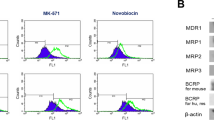Abstract
Purpose: Microscopic methods to measure the activity of drug extrusion systems important in multidrug resistance in individual cells were developed. Methods: Multidrug-resistant (MDR) and parental lines of hamster CHO and pituitary GH3 cells were incubated with the acetoxymethylester (AM) forms of several fluorescent calcium-sensing dyes, fura2, indo1 and fluo3. The AM forms of these compounds are hydrolyzed by intracellular esterases and then trapped in cells, and the AM forms of the dyes are excellent substrates for P-glycoprotein (Pgp). Results: The fluorescent free acid forms of fura2, indo1 and fluo3 did not accumulate in MDR lines unless a chemosensitizer such as cyclosporin A, R(+)verapamil, quinidine, or progesterone was included during loading to prevent the cells from extruding the AM forms of the dyes before they could be hydrolyzed. Cyclosporin A increased the fluorescence due to intracellularly trapped fura2 free acid from 8- to 20-fold and was maximally effective at <5 μM. Fluorescence microscopy was employed to measure fura2 free acid accumulation by parental and MDR cell lines using excitation at the Ca2+-insensitive wavelength. When MDR cells were incubated with rhodamine 123 and fura2/AM, no fluorescence was detectable. Cellular fluorescence was dramatically increased by inclusion of cyclosporin A, quinidine, progesterone, or R(+)verapamil. There was no measurable decline in the fura2 free acid fluorescence in 1 h while the fluorescence due to rhodamine 123 diminished rapidly in cells overexpressing Pgp. Conclusions: These fluorescence methods detect drug-extruding activity in individual cells and therefore have the potential to provide complementary information to studies quantifying protein or mRNA levels of Pgp or other efflux pumps. In addition, they provide a rapid and quantifiable method for screening multidrug resistance reversing agents.
Similar content being viewed by others
Author information
Authors and Affiliations
Additional information
Received: 15 August 1997 / Accepted: 16 January 1998
Rights and permissions
About this article
Cite this article
Nelson, E., Zinkin, N. & Hinkle, P. Fluorescence methods to assess multidrug resistance in individual cells. Cancer Chemother Pharmacol 42, 292–299 (1998). https://doi.org/10.1007/s002800050820
Issue Date:
DOI: https://doi.org/10.1007/s002800050820




